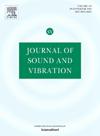Dynamic response influenced by joint contact uncertainties in complex machinery
IF 4.3
2区 工程技术
Q1 ACOUSTICS
引用次数: 0
Abstract
The contact characteristics of joints in complex machinery often exhibit uncertainty, directly affecting dynamic performance and stability. The principal scientific challenge is to establish a dynamic model for complex systems that accounts for the uncertain contact characteristics of joints. This study focuses on the uncertain contact mechanisms of joints distributed across complex systems, providing a new and efficient method for system dynamic analysis under joint uncertainty. The transfer matrix method for multibody systems and fractal theory are utilized to construct a dynamic model that integrates the three-dimensional contact micromechanics of joints with the macroscopic structural features of rigid-flexible coupled multibody systems. An improved interval arithmetic is developed to characterize uncertain contact behaviors. It incorporates the overall transfer principle and Taylor inclusion function to decouple interval operations from complicated computations, thereby effectively controlling interval expansion and enhancing computational accuracy. The proposed method is applied to an ultra-precision three-axis single-point diamond machine tool and validated experimentally. Through orthogonal analysis, the impacts of different joints on the dynamic response of the ultra-precision machine tool are revealed, identifying key joints and critical contact factors. This approach significantly contributes to the forward design and dynamic optimization of complex machinery.

求助全文
约1分钟内获得全文
求助全文
来源期刊

Journal of Sound and Vibration
工程技术-工程:机械
CiteScore
9.10
自引率
10.60%
发文量
551
审稿时长
69 days
期刊介绍:
The Journal of Sound and Vibration (JSV) is an independent journal devoted to the prompt publication of original papers, both theoretical and experimental, that provide new information on any aspect of sound or vibration. There is an emphasis on fundamental work that has potential for practical application.
JSV was founded and operates on the premise that the subject of sound and vibration requires a journal that publishes papers of a high technical standard across the various subdisciplines, thus facilitating awareness of techniques and discoveries in one area that may be applicable in others.
 求助内容:
求助内容: 应助结果提醒方式:
应助结果提醒方式:


